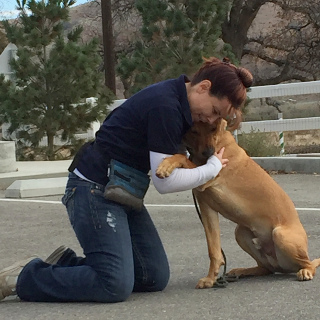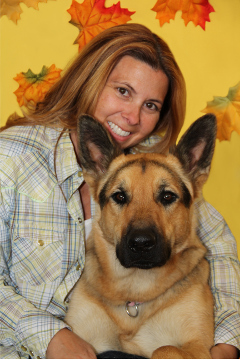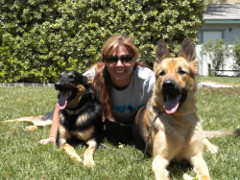The goal of socialization is to help the dog learn to act appropriately around people, other animals, and in the many public and private social situations of human life. It is not a one time, short term experience. Socialization is the on-going exposure of the dog to all experiences of life. Developing a dog that is mentally balanced, and able to readily adapt to changing environments, cannot be approached haphazardly.
A most important quality in a pet is his temperament. A dog with a good temperament can be a dream to live with, but a dog with a tricky temperament is a perpetual nightmare. A dogs temperament, especially his feelings toward people and other dogs, is primarily the result of his level of socialization during puppy-hood the most important time in a dogs life. Please don't waste this golden opportunity.
Raising and training a pup to be people-friendly is the second most important goal of pet-dog husbandry. Of course teaching bite inhibition is always the most important goal, but during your pup's first month at home, urgency dictates that socialization with people is the prime puppy directive.
As a rule of thumb, your puppy needs to meet about a hundred people before he is three months old. Since puppies of this age are still too young at this time to venture out on the streets, you'll need to start having puppy parties and invite friends over to hand feed your pup and help train him for you. Unfortunately, even a short period of social isolation at such a crucial developmental stage could all but ruin your puppy's temperament.
The first and most critical period in the development of a dog from puppy to adulthood that needs special attention is 7-14 weeks. Consequently, there is considerable urgency to introduce your puppy to a wide variety of people family, friends and strangers, and especially to men and children. Remember your pup should meet an average of three unfamiliar people a day.
So don't keep your puppy a secret - invite a bunch of men over to watch the game, invite women and children over for chocolate or ice cream, take the puppy to the office with you, etc.
Three Goals of Socialization
- Teach your puppy to enjoy the presence, actions and antics of all people first the family, then friends, and then strangers (especially children and men). Most adult dogs tend to feel most uneasy around children and men, especially little boys if they grow up with few or none around, or if his social contact as a puppy had been unpleasant or scary.
- Teach your puppy to enjoy being hugged and handled (restrained and examined) by people, especially by children, veterinarians and groomers. Mainly around his collar, muzzle, ears, paws and tail.
- Teach your puppy to enjoy giving up valued objects when requested, especially the food bowl, bones, balls, chew-toys, garbage, etc.
People:
People and dogs get along best when each is respectful of the other. Unfortunately for the dog, many humans have no idea how to be respectful from the dog's point of view, and thus the burden of appropriate action falls most heavily on the canine. The dog must be prepared to meet low voiced and towering humans that unintentionally present a threatening aura, and small children that back them in a corner.
The dog must learn to be confident around men, women, young children, and even the elderly. It is best to think ahead of any human type behavior the dog may possibly face in the future and set up appropriate scenarios. Expose them to various ethnic groups, sizes of people and all manner of dress and deportment, like people wearing hats or glasses, thick jackets, men with beards, etc. Other examples include people using walkers, canes or wheelchairs and those holding umbrellas.
Environment:
Environmental challenges can come in the most mundane form. There are dogs that absolutely refuse to walk on the tile floor, others that find a glass door an unexpected and painful barrier. Careful and planned introduction into new environments should start early and with short duration. Dogs should be exposed to various types and levels of noises, visual stimuli, along with a variety of texture and walking surfaces including tile, gravel, cement, linoleum, grass, wood, etc. When introducing the dog to what could possibly be a frightening situation, it is especially critical that the trainer remain calm, and transmit that composure and confidence to the dog. A tight leash, or letting the dog lead its handler away from such situations, has put the human in the follower position with the dog fully in charge. The training has now moved from socialization to fear reinforcement, and the probable development of fear aggression.
It is also possible for activities not previously causing undesirable reaction to become ones that are unexpectedly doing so. This may be because there are later periods which require awareness of the dogs mental development. These periods are generally in the time frames of 4-6 months, 8-10 months, and sometimes as late as 16-20 months of age. In all cases of expected or unexpected shy or fearful behavior, it is vital that behavior not be reinforced with coddling or soothing. The dog's actions must be met with the handler's confident, normal demeanor and tone of voice.
Fearful and aggressive attitudes regarding a given situation won't go away just because they are ignored, or have been brought under control at a given point. Continuous (over the full life of the dog) and repetitive exposure to the vagaries of life is a necessary part of socialization. It is a lifelong activity, and those activities not revisited will fade in the order of reliable and predictable response.
Tami Kearney
Mtn Top K-9 Training
Adopting Rescued or Sheltered Pets

Many shelters have wonderful dogs and cats available, and one of them can be the perfect addition to your household, but adopting a rescue dog or cat is a big responsibility. Lets face it, your not just adding to your family, you are quite literally saving a life; however, they come from various backgrounds and have had an array of experiences, which may be unknown to us.
When you bring a new rescued pet into your home, dogs in particular, you need to provide structure, routine, and leadership. Cats, though often more independent and flexible, also need to know that your house comes with a set of rules. Providing this structure from the very beginning makes the transition into their new home quicker, and smoother.
Establishing ground rules:
In order to provide that structure and leadership, everyone in the household needs to be on the same page about allowing pets on the furniture, sleeping on the bed, and access to all the rooms of the house. If adopting a cat, where does the litter box go? If adopting a dog, who will walk and clean up after him? Everyone must stay consistent with what they decide or the pet will get confused, which can cause stress and tension. If you don't make the rules, your pet will, and you won't be very happy about that.
Make sure to be prepared before your animal comes home: Purchase your collars, ID tags, leashes (if adopting a dog), food/water bowls, toys, treats and bedding. Potty pads for puppies, and a crate if you intend on crate training, litter boxes (if adopting a cat), and grooming supplies.
You'll ideally want to bring you new pet home when you have a few days so you can keep an eye on them as they explore their new space and learn your house rules. But you can practice leaving for 10min here and there to make sure they don't go into shock when you do finely leave them on your next work day. With a dog, make sure to walk him a bit and let them relieve themselves before coming into the house. This also helps establish lines of communication and social structure. With a cat, you may want to limit their area to one room at a time, especially if you have other animals they can get used to each others scents by sniffing under door frames.
The first few days:
It is not uncommon for rescue pets to come from a bad situation - neglect, abuse, trauma, and you can bet they will bring that baggage with them. That's why it is important you recognize that the first few days will be scary and uncertain for them.
You may, at first, consider limiting your rescue pet to one room or area. Setting up baby gates in doorways (if you have that option) is a great way to let them become familiar with their environments sights and sounds, but maintain their own safe private space. You can go in the room and spend some time helping them to become more comfortable with toys, treats, and if their open to it, cuddles. Don't be surprised if your new friend is shy and wary. Don't force anything, but be calm, gentle and consistent presence.
If you have other pets, don't leave them alone together until you have monitored interactions for a period of time. Make sure they get along, or at least tolerate each other before doing so for any length of time.
For the first few days, limit visitors in your house, especially if you've adopted a shy, wary pet, so he/she has time to get comfortable with their new family. When guest do finally come over, make sure they know the ground rules. Socializing a new pet is very important, so ask for their help on whatever your working on.

Vet visits:
While it is important that your dog sees a veterinarian soon after adoption, a trip to the vet can be a very scary thing. Take a week to get them as calm and comfortable with you as possible.
Take dogs for walks and car rides. Cats can be fed in crates, and maybe put in running car. And remember... to reward all behavior you want to see repeated.
Don't be to alarmed or angry about house training accidents. Even if you've adopted an adult rescue animal, being in a new territory and establishing a new routine means accidents will happen. This isn't something they should be punished for, but it's a behavior you'll need to correct so it doesn't become a habit. Praising and rewarding the right behavior is the best way to train, along with crate training for puppies.
A Trained pet makes for a happy home:
Never underestimate the value of a good training class. Remember, dogs are pack animals, and therefore like structure and order. They are also very social, and their personalities can depend on the pack.
Your animal shelter may have given your rescue dog a behavioral evaluation, but rarely are these for cats. Cats are independent and will typically try something a few times before they recognize that it's off limits. Like dogs, cats also respond better to rewarding and praise, and are more likely to do what you want if their relationship with you is loving and fun.
Bringing home a rescue pet is a very rewarding experience. Being prepared and making training a priority will help build a loving bond between you and your pet. Balancing structure, understanding and affection, your rescue pet will become a wonderful companion.
Tami Kearney
Mtn Top K-9 Training
Crate Training/Housebreaking
What is Crate Training?

Crate training is the process of conditioning your dog to accept being in a crate, which will eventually become his own den.
Crate training is used for a variety of reasons: it is an effective tool for housebreaking, and gives your dog a safe, secure place of his own. Having a dog who is comfortable being crated is also useful for confinement for short periods when necessary, for safe transportation via car or plane, and for keeping a dog calm and confined when recovering from surgery.
Dogs have a natural instinct not to soil where they sleep, and this is what makes crate training such an effective housebreaking tool as well.
What Type and Size of Crate will I Need?
There are two main types of crates. The better choice is the hard plastic kind that consists of a top and bottom that snap together, has ventilated slats on the sides, and a metal grille door. There are also crates made of heavy gauge wire that fold down into a suitcase shape. These are NOT approved for airline use, but some people prefer them for heavy-coated breeds because they offer better ventilation. Both can get costly, but the investment is well worth it in the long run. A damaged carpet alone would cost you more to replace!
The crate should be just big enough for your dog to stand up and turn around in. If your dog is a puppy, do NOT buy a huge crate for him to grow into. Having all that room will defeat the purpose. You may need to buy a puppy-sized crate now and a larger one later or purchase a crate that comes with dividers so you can gradually expand the puppy's space as needed.
Is Crate Training for Adult Dogs, too?
Yes, absolutely! Many people are under the false impression that crate training is just for puppies, and that older dogs will not take to a crate. Untrue! Older dogs often learn faster than puppies, and most will appreciate the comfort and security a crate offers.
How do I Introduce my Dog to the Crate?
Put a blanket or old sweatshirt that has your scent on it in the bottom of the crate. This will not only be comfortable for your dog, but helps the bonding process as well. (Note: There are some dogs who will urinate if soft bedding is present; if this is the case with your dog, remove the bedding altogether.) Keep the crate where you want your dog to sleep, for example, by the side of your bed. When you first introduce the crate, be sure the door is propped open so as to not swing shut by accident. If your dog doesn't go in to explore on his own, toss treats inside, or feed a few meals in there. Try not to force your dog into the crate (this could form an unpleasant association and make things more difficult for both of you). Each time your dog goes into the crate, say, Go to bed
or kennel
in a high, pleasant voice. Your dog will eventually come to associate the verbal cue with going into the crate.
The first night, say, Go to bed
or kennel
as you gently help your dog in, then softly close the door. You may want to put a toy in with him. It is perfectly normal for a dog to whine, bark, or even throw tantrums the first night in a crate. Do NOT reward the behavior by petting your dog, whispering soothing words, or worse, by letting him out. Try simply ignoring him for a while. If he doesn't stop after a reasonable amount of time, simply say, No
in a firm voice, or tap the top of the crate and say, Quiet.
Just don't get into the cycle of your dog whining and you saying, Quiet
each time, thereby reinforcing the behavior by responding to it at all. There are some dogs who will have trouble holding their bladder all night (usually young pups). You will quickly come to know the difference between a normal whine and a need-to-urinate whine. If the whining becomes frantic during the night, open the crate door, pick your dog up, and bring him out to the spot where you want him to eliminate. As he does, praise him in a high, happy voice, then immediately return him to the crate. Most dogs get used to this routine very quickly and soon sleep through the night without interruption.
Daily Routine
First thing in the morning, open the crate door and carry your dog to the preferred elimination spot. (If you let him walk out on his own he might urinate before making it to the door.) As soon as your dog begins to circle and sniff, or otherwise indicates that he is about to potty, use a soft verbal coaxing, Go potty!
Over time, by repeating your instruction just before he urinates, your dog will eventually become conditioned to urinate upon hearing your verbal cue. (Use the verbal cue each time you take your dog out to potty, just be sure to wait for signs that he is about to go before you say it.) When he goes, reward lavishly with a little play and a few treats. After the morning elimination, either place your dog in a baby-gated area such as the kitchen, or keep him with you, tethered to you with a long line or tethered to a nearby piece of furniture where he'll be within your sight. Do not let your dog out of your sight, as accidents happen in a split second; you need to be there to interrupt as they happen. Your dog can also be crated for brief periods during the day if you are unable to keep an eye on him, for example, if you need to take a shower.
If you notice your dog starting to circle and sniff or squat, startle him with a sharp verbal, Eh-eh!
(or if necessary, by clapping your hands), then quickly bring him to the proper elimination spot. If he goes, don't forget the praise! If you find an accident that has already happened, consider it your own mistake and clean it up quietly. A dog will not associate a correction with what he did wrong if it's after the fact. Take your dog out to eliminate upon waking after naps, after meals, after playtime, and before bedtime. That means standing outside with him so you can praise him when he goes, as opposed to letting him out and assuming he's done his business.
If you must leave the house, you can leave your dog crated up to 3-6 hours at a time, depending on age. This will prevent housebreaking accidents as well as preventing unwanted chewing or destruction. Potty your pup before placing him in the crate, and place a favorite safe toy or bone in the crate with him.
Once your dog is housebroken, you can still use the crate for confinement periods if necessary. Many people end up taking the door off the crate entirely, and their dogs still sleep, hang out, and take refuge in their dens.
Crate training is well worth the time and investment, and giving this permanent place of safety and comfort to your dog is really a gift to you both.
Tami Kearney
Mtn Top K-9 Training





